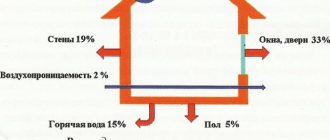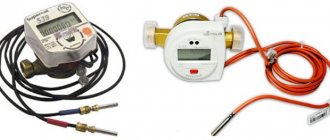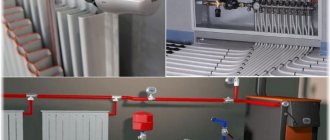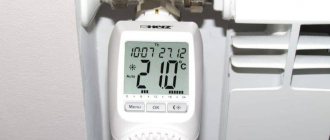What is Gcal?
A calorie is a certain amount of energy that is required to heat 1 gram of water to 1 degree. This condition is met under atmospheric pressure conditions. For thermal energy calculations, a larger value is used - Gcal. A gigacalorie corresponds to 1 billion calories. This value began to be used in 1995 in accordance with the document of the Ministry of Fuel and Energy.
In Russia, the average consumption per 1 sq.m. is 0.9342 Gcal per month. In each region, this value may change up or down depending on weather conditions.
What is a gigacalorie if it is converted into ordinary values?
- 1 Gigacalorie equals 1162.2 kilowatt-hours.
- In order to heat 1 thousand tons of water to a temperature of +1 degree, 1 gigacalorie will be required.
What are calories
During the construction of buildings, all measurements and thermal calculations are made in gigacalories. Utilities also prefer this unit of measurement for its proximity to real life and the possibility of calculations on an industrial scale.
We remember from the school course that a calorie is the work needed to heat 1 gram of water per unit °C (at a certain atmospheric pressure).
In life you have to deal with Kcal and Gcal, gigacalories.
- 1 Kcal = 1 thousand cal.
- 1 Gcal = 1 million Kcal, or 1 Billion. cal.
The following measurement can be used in heating receipts:
- Gcal;
- Gcal/hour.
In the first case, we mean the supplied heat for a certain period (this could be a month, a year or a day). Gcal/hour is a characteristic of the power of a device or process (such a unit of measurement can indicate the performance of a heating device or the rate of heat loss of a building in winter). The receipts imply heat that was released in 1 hour. Then, to recalculate for a day, you need to multiply the number by 24, and for a month by another 30/31.
1 Gcal/hour = 40 m3 of water, which was heated to 25 °C in 1 hour.
Also, a gigacalorie can be tied to the volume of fuel (solid or liquid) Gcal/m3. And it shows how much heat can be obtained from a cubic meter of this fuel.
Gcal in apartment buildings
In apartment buildings, gigacalories are used in thermal calculations. If you know the exact amount of heat energy that remains in the house, you can calculate the bill for heating. For example, if a house does not have a communal or individual heating device installed, then you will have to pay for centralized heating based on the area of the heated room. If a heat meter is installed, then the wiring is horizontal, or serial, or collector. In this option, two risers are made in the apartment for the supply and return pipes, and the system inside the apartment is determined by the residents. Such schemes are used in new houses. That is why residents can independently regulate the consumption of thermal energy, making a choice between comfort and savings.
The adjustment is made as follows:
- Due to the throttling of heating batteries, the passage of the heating device is limited, therefore, the temperature in it decreases and the consumption of thermal energy decreases.
- Installation of a general thermostat on the return pipe. In this option, the flow rate of the working fluid is determined by the temperature in the apartment, and if it increases, then the flow rate decreases, and if it decreases, then the flow rate increases.
Gcal in private homes
If we talk about Gcal in a private house, then residents are primarily interested in the cost of heat energy for each type of fuel. Therefore, let’s look at some prices per 1 Gcal for various types of fuel:
- Natural gas – 3300 rubles;
- Liquefied gas – 520 rubles;
- Coal – 550 rubles;
- Pellets – 1800 rubles;
- Diesel fuel – 3270 rubles;
- Electricity – 4300 rubles.
The price may vary depending on the region, and it is also worth considering that the cost of fuel increases periodically.
General information about Gcal calculations
To calculate Gcal, it is necessary to make special calculations, the procedure of which is established by special regulations. The calculation is carried out by utility services, which can explain to you the procedure for calculating Gcal, as well as decipher any unclear points.
If you have an individual device installed, you will be able to avoid any problems and overpayments. All you need to do is take the readings from the meter every month and multiply the resulting number by the tariff. The amount received must be paid for the use of heating.
Heat meters
In order to calculate thermal energy you need to know the following information:
- The temperature of the liquid at the inlet and outlet of a certain section of the pipeline.
- The flow rate of liquid that moves through heating devices.
Consumption can be determined using heat meters. Heat meters can be of two types:
- Vane counters. Such devices are used to measure thermal energy, as well as hot water consumption. The difference between such meters and devices for metering cold water is the material from which the impeller is made. In such devices it is most resistant to high temperatures. The operating principle is similar for the two devices:
- The rotation of the impeller is transmitted to the metering device;
- The impeller begins to rotate due to the movement of the working fluid;
- The transfer is carried out without direct interaction, but with the help of a permanent magnet.
Such devices have a simple design, but their response threshold is low. They also have reliable protection against reading distortion. Using an antimagnetic screen, the impeller is prevented from braking by the external magnetic field.
- Devices with a difference recorder. Such meters operate according to Bernoulli's law, which states that the speed of a liquid or gas flow is inversely proportional to its static movement. If the pressure is recorded by two sensors, the flow can be easily determined in real time. The counter involves electronics in the design. Almost all models provide information on the flow and temperature of the working fluid, and also determine the consumption of thermal energy. You can configure the work manually using a PC. You can connect the device to a PC via a port.
Many residents are wondering how to calculate the amount of Gcal for heating in an open heating system in which hot water can be selected. Pressure sensors are installed on the return and supply pipes at the same time. The difference in the flow rate of the working fluid will show the amount of warm water that was spent for domestic needs.
Other methods for calculating heat volume
You can calculate the amount of heat entering the heating system in other ways.
The formula for calculating heating in this case may differ slightly from the above and have two options:
- Q = ((V1 * (T1 - T2)) + (V1 - V2) * (T2 - T)) / 1000.
- Q = ((V2 * (T1 - T2)) + (V1 - V2) * (T1 - T)) / 1000.
All variable values in these formulas are the same as before.
Based on this, we can say with confidence that the calculation of kilowatts of heating can be done on your own. However, do not forget about consultation with special organizations responsible for supplying heat to homes, since their principles and calculation system may be completely different and consist of a completely different set of measures.
Having decided to construct a so-called “warm floor” system in a private house, you need to be prepared for the fact that the procedure for calculating the volume of heat will be much more complicated, since in this case it is necessary to take into account not only the features of the heating circuit, but also provide for the parameters of the electrical network from which and the floor will be heated. At the same time, the organizations responsible for monitoring such installation work will be completely different.
Many owners often face the problem of converting the required amount of kilocalories into kilowatts, which is due to the use of measuring units in the international system called “C” by many auxiliary aids. Here you need to remember that the coefficient converting kilocalories into kilowatts will be 850, that is, in simpler terms, 1 kW is 850 kcal. This calculation procedure is much simpler, since calculating the required volume of gigacalories is not difficult - the prefix “giga” means “million”, therefore, 1 gigacalorie is 1 million calories.
In order to avoid errors in calculations, it is important to remember that absolutely all modern heat meters have some error, but often within acceptable limits. The calculation of such an error can also be done independently, using the following formula: R = (V1 - V2) / (V1 + V2) * 100, where R is the error of the common house heating meter. V1 and V2 are the parameters of water flow in the system already mentioned above, and 100 is the coefficient responsible for converting the resulting value into a percentage. In accordance with operational standards, the maximum permissible error may be 2%, but usually this figure in modern instruments does not exceed 1%.
Formula for calculating Gcal for heating
If you do not have an individual device, then you need to use the following formula for calculating heat for heating: Q = V * (T1 – T2) / 1000, where:
- Q is the total amount of heat energy.
- V is the volume of hot water consumption. Measured in tons or cubic meters.
- T1 is the hot water temperature, measured in degrees Celsius. In such a calculation, it is better to take into account the temperature that will be characteristic of a specific operating pressure. This indicator is called enthalpy. If there is no necessary sensor, then take the temperature that will be similar to the enthalpy. Typically, the average temperature is between 60-65 degrees Celsius.
- T2 is the temperature of cold water, which is measured in degrees Celsius. As you know, getting to a pipeline with cold water is not easy, so such values are determined by constant values. They, in turn, depend on the climatic conditions outside the house. For example, in the cold season, this value can be 5 degrees, and in warm times, when there is no heating, it can reach 15 degrees.
- 1000 is a factor that gives the answer in gigacalories. This value will be more accurate than regular calories.
In a closed heating system, gigacalories are calculated in a different form. In order to calculate Gcal in a closed heating system, you must use the following formula: Q = ((V1 * (T1 - T)) - (V2 * (T2 - T))) / 1000, where:
- Q – previous volume of thermal energy;
- V1 is the heat carrier flow rate parameter in the supply pipe. The heat source can be water vapor or ordinary water.
- V2 – volume of water flow in the outlet pipe;
- T1 – temperature in the coolant supply pipe;
- T2 – temperature at the pipe outlet;
- T – cold water temperature.
Calculation of thermal energy for heating using this formula depends on two parameters: the first shows the heat that enters the system, and the second is the heat parameter when the coolant is removed through the return pipe.
Gcal and Gcal/h: what is the difference
If it is necessary to calculate the consumer's payment for state heat and power services (house heating, hot water), the value Gcal/h is used. It denotes a reference to time - how many Gigacalories are consumed during heating for a given period of time. Sometimes it is also replaced by Gcal/m3 (how much energy is needed to transfer heat to a cubic meter of water).
The value of Gcal/h can be calculated independently using this formula:
Q=V*(T1 – T2)/1000, where
- Q – amount of thermal energy;
- V – volume of liquid consumption in cubic meters/tons;
- T1 is the temperature of the incoming hot liquid, which is measured in degrees Celsius;
- T2 – temperature of the incoming cold liquid, similar to the previous indicator;
- 1000 is an auxiliary coefficient that simplifies calculations by eliminating numbers in the tenth digit (automatically converts kcal to Gcal).
This formula is often used to construct the operating principle of heat meters in private apartments, houses or enterprises. This measure is necessary when the cost of this utility service sharply increases, especially when calculations are generalized based on the area/volume of the room that is heated.
If a closed type system is installed in the room (hot liquid is poured into it once without additional water), the formula is modified:
Q= (( V1* (T1 – T2)) – (V2* (T2 – T)))/ 1000, where
- Q – amount of thermal energy;
- V1 – volume of consumed thermal substance (water/gas) in the pipeline through which it enters the system;
- V2 is the volume of thermal substance in the pipeline through which it returns;
- T1 – temperature in degrees Celsius in the inlet pipeline;
- T2 – temperature in degrees Aim in the outlet pipeline;
- T – cold water temperature;
- 1000 – auxiliary coefficient.
This formula is based on the difference between the inlet and outlet values of the coolant in the room.
Depending on the use of a particular energy source, as well as the type of thermal substance (water, gas), alternative calculation formulas are also used:
- Q= (( V1* (T1 – T2)) + (V1 – V2)*( T2 – T))/1000
- Q= (( V2* (T1 – T2)) + (V1 – V2)*(T1 – T))/1000
In addition, the formula changes if electrical devices are included in the system (for example, heated floors).
Other methods for calculating Gcal for heating
You can calculate the amount of heat that enters the heating system in other ways. For example, the formula for calculating Gcal can have two other forms:
- Q = ((V1 * (T1 - T2)) + (V1 - V2) * (T2 - T)) / 1000.
- Q = ((V2 * (T1 - T2)) + (V1 - V2) * (T1 - T)) / 1000.
All values in these formulas are the same as in the previous formula. Based on the above calculations, we can conclude that you can calculate Gcal for heating yourself. But you should seek advice from special companies that are responsible for supplying heat to the house, since their work and calculation system may differ from these formulas and consist of a different set of measures.
If you decide to make a “Warm Floor” system in your private home, then the principle of heating calculation will be completely different. The calculation will be much more complicated, since it is necessary to take into account not only the features of the heating circuit, but also the values of the electrical network from which the floor is heated. The companies that are responsible for monitoring the installation of heated floors will be different.
Many residents have difficulty converting kilocalories to kilowatts. This is due to many manuals of measuring units in the international system, which is called “C”. When converting kilocalories to kilowatts, the coefficient 850 should be used. That is, 1 kW equals 850 kcal. This calculation is much simpler than others, since it is not difficult to find out the required volume of gigacalories. 1 gigacalorie = 1 million calories.
During the calculation, it should be remembered that any modern devices have a small error. Mostly they are acceptable. But you need to calculate the error yourself. For example, this can be done using the following formula: R = (V1 - V2) / (V1+V2) * 100, where:
- R – error of a common house heating device.
- V1 and V2 are the previously indicated water flow parameters in the system.
- 100 is the coefficient that is responsible for converting the resulting value into a percentage. In accordance with operational standards, the maximum error that can be is 2%. Basically, this figure does not exceed 1%.
Calculation procedure when calculating heat consumption
In the absence of such a device as a hot water meter, the formula for calculating heat for heating should be as follows: Q = V * (T1 - T2) / 1000. The variables in this case display values such as:
- Q in this case is the total amount of heat energy;
- V is the indicator of hot water consumption, which is measured either in tons or in cubic meters;
- T1 – temperature parameter of hot water (measured in standard degrees Celsius). In this case, it would be more appropriate to take into account the temperature that is characteristic of a certain operating pressure. This indicator has a special name - enthalpy. But in the absence of the required sensor, you can take as a basis the temperature that will be as close as possible to the enthalpy. As a rule, its average varies between 60 and 65°C;
- T2 in this formula is the temperature indicator of cold water, which is also measured in degrees Celsius. Due to the fact that getting to the pipeline with cold water is very problematic, such values are determined by constant values, which differ depending on the weather conditions outside the home. For example, in the winter season, that is, at the height of the heating season, this value is 5°C, and in the summer, when the heating circuit is turned off, it is 15°C;
- 1000 is a common coefficient that can be used to get the result in gigacalories, which is more accurate, rather than in regular calories.
Calculation of Gcal for heating in a closed system, which is more convenient for operation, should be done in a slightly different way. The formula for calculating heating of a room with a closed system is as follows: Q = ((V1 * (T1 - T)) - (V2 * (T2 - T))) / 1000.
- Q – still the same volume of thermal energy;
- V1 is the coolant flow parameter in the supply pipe (the heat source can be either ordinary water or steam);
- V2 – volume of water flow in the outlet pipeline;
- T1 – temperature value in the coolant supply pipe;
- T2 – outlet temperature indicator;
- T – temperature parameter of cold water.
Results of calculations of Gcal for heating
If you have correctly calculated the consumption of Gcal of thermal energy, then you do not have to worry about overpayments for utilities. If we use the above formulas, we can conclude that when heating a residential building with an area of up to 200 sq.m. you will need to spend about 3 Gcal in 1 month. If we consider that the heating season in many regions of the country lasts approximately 6 months, then we can calculate the approximate consumption of thermal energy. To do this, multiply 3 Gcal by 6 months and get 18 Gcal.
It is much easier to calculate gigacalorie consumption in a private home, since you can install your own individual device there. In apartment buildings with centralized heating, it will not be possible to get by with a conventional appliance.
Based on the information indicated above, we can conclude that all calculations on the consumption of thermal energy in a particular house can be done independently without the help of special organizations. But it is worth remembering that all data must be calculated accurately using special mathematical formulas. In addition, all procedures must be coordinated with special bodies that control such actions. If you are not sure that you will perform the calculation yourself, then you can use the services of professional specialists who are engaged in such work and have materials available that describe in detail the entire process and photos of heating system samples, as well as their connection diagrams.
How to calculate Gcal for heating - the correct calculation formula
Often, one of the problems that consumers face both in private buildings and in apartment buildings is that the consumption of thermal energy obtained in the process of heating a home is very large. In order to save yourself from the need to overpay for excess heat and to save money, you should determine exactly how the amount of heat for heating should be calculated. Conventional calculations will help solve this, with the help of which it will become clear what volume the heat entering the radiators should have. This is exactly what will be discussed further.









